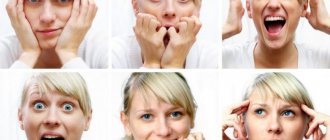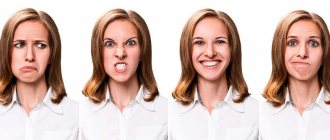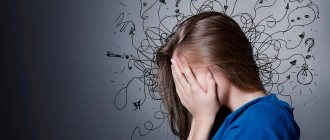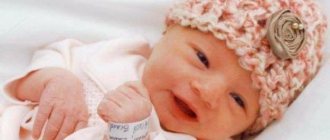Recurrent depressive disorder is a type of mood disorder.
Recurrent depression is characterized by the occurrence of mild, moderate, and severe depressive episodes. Often, such symptoms can be accompanied by episodes of elevated mood and hyperactivity following depressive episodes.
Without objective anamnestic data, it cannot be said that this is hypomania. The elevated mood may be a result of the treatment.
What is recurrent depression?
Recurrent (lat. recurrens - “returning”) disorder is established when depressive episodes are repeated throughout the year with a certain frequency.
Each of them is associated with loss of interests, persistently depressed mood, and increased mental and physical fatigue. The ICD-10 code is F33. Between periods of exacerbation, a person feels absolutely normal (intermission). To make a diagnosis, symptoms must meet DSM-V and ICD-10 (International Classification of Diseases, 10th Revision) criteria. It is important that there is no history of hyperactivity or inappropriately elevated mood associated with mania. When they appear, the conclusion is changed to “bipolar affective disorder” (F31. -).
Suicide due to depression
The most severe and tragic result of depression is suicide. Of the fifteen to twenty million suicide attempts, about half occur among people with depressive mental disorders. In general mortality statistics, completed suicide as a result of depression is in eighth place, behind such pathologies as coronary heart disease, pneumonia, oncology, as well as accidents (road accidents, fires).
One in seven people with depression have attempted suicide. If we take into account tendencies towards suicide, self-destruction and an increased risk of somatic diseases (hypertension, angina, dermatological and endocrine diseases), then depressive disorder shortens a person’s life by about 10 years.
Reasons for development
It is still unknown what exactly leads to the formation of affective disorders (mood pathologies). The role of the following factors is suspected:
- genetically determined insufficiency of the activity of the main neurotransmitters of the central nervous system (norepinephrine, dopamine, serotonin, melatonin) - monoamine theory;
- psychosocial distress;
- reaction to a traumatic event (individual for a person);
- endocrine (hormonal) imbalance;
- the presence of somatic disability, for example, disability or severe chronic disease.
The occurrence of the first depressive episodes may be a response to external provocative events, usually psychological trauma. Repeated exacerbations usually have no connection with external conditions.
The majority of patients are women, but every year the number of men seeking help increases. Without treatment, 85% experience frequent relapses with a tendency to protracted course.
Schizoaffective disorder: difference from schizophrenia
Schizoaffective disorder is an endogenous psychosis, without a progressive (progressive) course, in contrast to schizophrenia, which is a chronic progressive mental illness that destroys the personality. ORB is characterized not by continuous, but by periodic manifestations of pathology. In the patient’s life, episodes of psychosis occur (exacerbations, attacks), which can go away on their own without treatment. The rest of the time the patient exists safely, because the schizophrenic defect grows extremely slowly, which practically does not lead to social maladjustment.
Symptoms
The recurrent nature of the disease is confirmed if the patient suffered at least 2 episodes (or one severe one), each of which lasted two weeks or more. In this case, a person must have intervals of normal life between exacerbations of at least two months.
A depressive episode has the following symptoms:
- The main ones: unexplained fatigue, a feeling of constant decrease in energy, the inability to experience positive emotions from previous activities (which previously brought joy), low mood.
- Additional: disturbances in appetite and sleep, a pessimistic view of the future, decreased self-esteem, uncertainty in all areas of life, deterioration in concentration, pathological ideas of guilt (self-deprecation).
- The symptoms are not caused by brain damage.
- Apart from depressive episodes, no hypomanic symptoms were noticed from the onset of the disease.
Clinical manifestations intensify closer to the morning. The resulting disturbances can affect libido, reduce mental and cognitive activity, and negatively affect performance. In severe cases, symptoms significantly impair social functioning; delusions, hallucinations, and stupor may occur.
After the end of the depressive episode, the patient returns to the previous level of life that was before the disease. In approximately 20-30% of cases, mild residual symptoms persist, which can be effectively relieved with therapy.
RECURRENT DEPRESSIVE DISORDER
Recurrent depression (or recurrent depressive disorder) is a mental disorder characterized by repeated episodes of depressed emotional state with varying degrees of severity and duration. Depressive periods most often occur at regular intervals, their time intervals can range from 3 to 12 months. Each patient has his own individual rhythm of relapses. Between them there are periods that can be described as calm, during which the psyche and behavior are normal.
The causes of the development of recurrent depressive disorder are three groups of factors: endogenous (disorders of protein metabolism, genetic predisposition and other internal factors), psychogenic (any traumatic situations and standard life situations, for example, retirement, job loss, financial difficulties), and also organic (associated with lesions in the brain or nervous system). Most often, the first episode of depression is triggered by psychogenic causes.
Detection of recurrent depressive disorder
Recurrent depression is diagnosed both easier and, at the same time, more difficult than other types. The ease lies in the fact that an experienced eye will notice that periods of depression are replaced by periods of adequate, normal behavior, which means the type is obvious. On the other hand, in order to notice the sequence of periods, it is necessary for time to pass until this pattern is revealed. Lost time means that the disease may be more difficult to treat than if detected at an earlier stage.
An experienced psychiatrist can usually identify recurrent depressive disorder at the first consultation. To do this, it is enough to collect an anamnesis (life history and illness), clarify the presence of diseases in blood relatives, check the physical condition and, most importantly, assess the patient’s mental functions at the present time. With depression (and with a recurrent depressive state), in addition to reduced mood, changes in thinking, in the volitional sphere are detected, attention and even the amount of RAM are reduced.
How to cure recurrent depression? Treatment in this case implies complexity, taking into account the individual characteristics of the patient and the course of the disease, and careful attention to the reasons that led to the onset of such a disorder. This approach can only be ensured in a good medical institution. The ROSA Clinic offers treatment services for recurrent depressive disorder through a combination of qualified psychotherapy, medications, biofeedback therapy, physiotherapy, diet therapy, massage and exercise therapy.
Treatment of recurrent depressive disorder
In mild cases
treatment is carried out at home (outpatient). Taking medications is combined with psychotherapeutic work. The duration of drug treatment can reach several months (from 3 to more than 12).
In case of moderate severity
(when due to illness it becomes difficult to cope with work or study, weight, sleep-wake cycle are disturbed) treatment is carried out in a day hospital. For a short time (from 1 to 3 hours), the patient comes to the clinic, where, under the supervision of a doctor, he receives medical procedures: intravenous administration of drugs, physical therapy, psychotherapeutic treatment. The recovering person spends the rest of the time at home. This type of therapy allows you to quickly stabilize the condition without taking you away from your usual environment. If necessary, a certificate of incapacity for work (sick leave) is opened for the period of treatment. The duration of the course is from several days to a month, on average - 10 days.
If the condition is serious
, then treatment is carried out in a specialized 24-hour hospital. Hospitalization allows the patient to be monitored and provides the opportunity to use intensive therapies.
Treatment of recurrent depressive disorder at the ROSA clinic:
- We work around the clock. We accept patients in both mild and severe condition.
- You can see a doctor both in the clinic and at home.
- Your own comfortable hospital.
- Experienced specialists in the field of depression treatment: psychiatrists, psychotherapists, neurologists, psychologists and rehabilitation specialists.
- Psychological support for relatives.
- Examination of the nervous system and mental sphere. All types of analyses. Own laboratory of functional diagnostics.
- Safe and intensive therapy methods. A combination of classical academic approaches with advanced scientific achievements. Large selection of non-drug treatment methods.
- The ROSA Clinic is licensed and certified to provide assistance for recurrent depressive disorder.
Kinds
To determine treatment tactics, it is important to establish the severity of the developed disease. Episodes may also differ in the severity of symptoms. Transformation into other types of depressive disorders, for example, bipolar affective disorder (BAD), is not excluded.
Lightweight
To confirm a mild variant, the appearance of 2 main and additional symptoms of the episode is necessary. People with such recurrent depression are able to maintain social functioning. However, the quality of life still decreases. Somatic manifestations may be absent.
Moderate
With moderate recurrent depression, performing everyday tasks becomes almost impossible. A person cannot normally analyze information, study or work. Interpersonal relationships among family, friends, and loved ones suffer. For diagnosis, 2 main and 3-4 additional symptoms are enough.
Heavy
A severe depressive episode dramatically disrupts the social well-being of the patient. He loses the ability to perform not only work, but also household duties. There is a critical loss of interest in what is happening, nothing brings joy.
In this case, all the main symptoms, as well as 4 or more additional ones, are observed. Some episodes are aggravated by psychotic symptoms - delusions, hallucinosis, movement disorders or stupor. Increased risk of suicidal behavior.
Depressive disorders are the second leading medical cause of disability and mortality. WHO (World Health Organization) calls for combating the problem at the international level, having adopted a special resolution in 2013.
Melancholic and anxious depression
In classical psychiatry, it is customary to distinguish melancholic and anxious depression, although the disorder is not limited to these forms.
Melancholic depression is the most severe form. Patients experience “vital” melancholy - it is described as physical pain in the soul, chest, neck, head. A person lies in bed for days facing the wall, stops talking and caring for himself. Nothing brings pleasure, even what he used to love very much. They have persistent thoughts of suicide, which are prevented from being realized only by a general loss of strength.
Important
Suicidal thoughts and intentions can be hidden from others, so depression requires the supervision of an experienced psychotherapist.
Anxious depression is expressed in hypochondriacal ideas (premonitions of non-existent diseases), anxiety due to negative future scenarios, pronounced vegetative-somatic manifestations - palpitations, chills, cold sweats, digestive disorders.
Clinical efficacy of inosine pranobex in recurrent respiratory infections
A study of the clinical effectiveness of inosine pranobex in ARI indicates that its use reduces the duration and severity of symptoms of the disease [1, 9, 11, 14, 20, 32].
M.Yu. Eliseeva et al. [34] conducted a meta-analysis of studies evaluating the effectiveness of inosine pranobex for respiratory infections in 2500 patients (children and adults) with immune system disorders and recurrent respiratory infections. A significant reduction in the frequency of new episodes of ARI was established after a treatment and prophylactic course of the drug inosine pranobex. The effectiveness of the use of inosine pranobex in a prophylactic regimen when compared with the indicators of the control group and/or baseline data before taking the drug in studies was as follows. L.V. Osidak et al. [8] during clinical observation of children (65.6% of preschoolers and 34.4% of schoolchildren) for four months, one or more courses of inosine pranobex were used. It was found that during the observation period, more than 80% of children who received both one and two courses of inosine pranobex never got sick, and 90.9% of those who received three courses did not get sick. Thus, it has been shown that inosine pranobex contributes to a significant reduction in the incidence of ARI for at least another 4 months.
M. Golebiowska-Wawrzyniak et al. [46] conducted a study of 40 children aged 3–15 years with recurrent respiratory infections. Inosine pranobex 50 mg/kg body weight for 10 days was prescribed to 30 children. Control group - 10 children received placebo. The observation period was 12 months. As a result, a decrease in the number of ARI episodes was revealed by 81.2% (5.31 times compared to what was before treatment with inosine pranobex), a decrease in the duration of diseases by 88.2% (8.44 times), a decrease in the frequency of use antibiotics by 93.5% (15.3 times) and drugs from other groups by 78.3% (4.51 times).
Another study found that the use of the drug inosine pranobex in the form of three courses of 10 days with an interval of 10 days in children with frequent episodes of respiratory diseases after sanitation of foci of chronic infection in the oro- and nasopharynx reduced the frequency of acute respiratory infections by three times, the frequency of relapses of bronchitis by three times. 2.3 times. In children with clinical manifestations of herpesvirus infection (rashes in the nasolabial area, aphthous stomatitis), 6 months after taking the drug, the number of exacerbations decreased by three times [16].
The experience of using inosine pranobex in closed children's institutions for 10 days with an 8-day break in the rehabilitation of frequently ill young children with herpetic infections showed that the average number of diseases per year decreased from 6.25 to 4 [24].
Currently, there are a number of other publications on the effectiveness of inosine pranobex in children with recurrent respiratory infections [22, 30, 33]. The generalized results indicate that the use of this drug reduces the severity and duration of ARI, reduces the number of repeated episodes of respiratory infections and complications, especially in children with a burdened premorbid background. An important result of the use of inosine pranobex is the reduction in the need for additional prescription of antibiotics and other drugs [16, 46].
Immunological basis of recurrent respiratory tract infections in children
The cause of recurrent respiratory infections is considered to be dysfunction of the immune system, which manifests itself under the influence of external factors (unfavorable environmental conditions, high anthropogenic load, social problems, etc.) [12]. Genetic predisposition, which is realized as a result of exposure to the above-mentioned unfavorable external factors, is also discussed. There is a high probability of having a hereditarily determined “late start” of the immune system.
Immunological abnormalities in children with recurrent respiratory infections are closely related to age-related characteristics of the maturation and development of their immune system. It has been established that changes in the immune status occur in 15–39% of such children, even during the period of clinical well-being and the absence of signs of ARI [4, 18]. Features of the immune response include its shift towards the Th2 type against the background of suppression of local immunity of the mucous membranes of the respiratory tract, as evidenced by a decrease in the level of IgA in saliva. Clear changes in phagocytosis are detected. A decrease in cellular cytotoxicity (the number of activated CD8DR+ cells) determines a decrease in antiviral immunity. Spontaneous hyperproduction of pro-inflammatory interleukins (IL-4, IL-6, IL-8) and disimmunoglobulinemia were established. In addition, in children with recurrent respiratory infections, disturbances in the interferon system are detected: in 80% of them, the ability of immunocompetent cells to synthesize interferon gamma is halved compared to their rarely ill peers. It has been established that even with adequate levels of serum interferon in this group of children, a decrease in the induced production of alpha and gamma interferons is observed, which reflects the insufficiency of the reserve capabilities of interferonogenesis [6, 14, 27].
The damaging effect of viruses is realized not only by affecting the mucous membrane of the respiratory tract, but also indirectly, by influencing the immune system. Viruses use various mechanisms of immunosuppression, while helping to reduce the body's resistance to the effects of other pathogens. Long-term (up to 4–6 weeks) persistence of respiratory viruses in nasopharyngeal epithelial cells and mononuclear blood cells after acute respiratory infections, even without clinical symptoms of the disease, has been established, especially in children with recurrent respiratory infections [10, 42, 45]. It is known that decreased immunity against the background of viral persistence contributes to the development of bacterial infection [10, 57]. Viruses not only reduce the barrier function of mucous membranes, but also have an allergenic effect [43]. As a result, a viral infection serves as a trigger for the formation of respiratory allergies in children [40, 55].
The impact of pathogenic factors of respiratory infection increases with repeated episodes of the disease, leading to the development of chronic inflammation of the mucous membrane of the respiratory tract and a decrease in the body’s resistance [28, 39]. That is why, when choosing drug treatment, one should take into account both the drug’s ability to suppress the reproduction of a wide range of respiratory viruses and restore reduced immune defense. One of the promising areas for optimizing the treatment of recurrent respiratory viral infections in children is the use of the drug inosine pranobex, which has a wide spectrum of antiviral and immunomodulatory activity.
Inosine pranobex: mechanisms of action
The drug inosine pranobex in the international anatomical-therapeutic-chemical classification of drugs (ATC) belongs to the subgroup of direct-acting antiviral drugs (J05A X05). The antiviral activity of inosine pranobex is determined by its effect on viral replication and modulation of the immune response [44, 46]. The drug suppresses the replication of DNA and RNA viruses due to integration into the ribosome of a cell affected by the virus, which slows down the synthesis of viral messenger RNA [3, 41, 50]. The drug has been proven to have high activity against adenoviruses, parainfluenza viruses, and RS virus, and moderate activity against influenza A and B viruses [8]. Inosine pranobex also exhibits antiviral activity against other pathogens of acute respiratory infections, herpes viruses (herpes simplex virus types 1, 2, herpes zoster, Epstein-Barr and cytomegalovirus), measles viruses, human papillomaviruses, etc. [29, 47].
A decrease in virus reproduction in the body when taking inosine pranobex also occurs indirectly due to the immunomodulatory effect. Inosine pranobex consists of two components - inosine (a purine metabolite) and an auxiliary component pranobex, which increases the tropism of the drug to lymphocytes, thereby enhancing the immunomodulatory effect [17].
Modulation of the immune response by cell type is manifested by a stimulating effect on the activity of cytotoxic T-lymphocytes, the function of T8 suppressors and T4 helpers. The influence on the cytokine status is realized by an increase in the production of interleukins (IL-1, IL-2) and a decrease in IL-4, inducing the secretion of endogenous interferon gamma. Inosine pranobex increases the functional activity of NK cells and potentiates chemotaxis by activating the function of neutrophils and macrophages [48, 56]. By stimulating the differentiation of B-lymphocytes into plasma cells and increasing the production of antibodies, the drug normalizes humoral immunity. In this case, there is an increase in the concentration of immunoglobulins (IgG, IgA, IgM), as well as surface markers of complement and virus-neutralizing antibodies [2].
An important advantage of the immunomodulatory effect of inosine pranobex is the low likelihood of pathogen development of resistance to this drug [5].
Drug therapy
Treatment of a depressive episode at Dr. Isaev’s clinic is carried out comprehensively. At the same time, an individual approach is taken to each patient. The main methods of providing assistance are medication and psychotherapy. Most often, to eliminate symptoms of low mood, the following are used:
- neuroleptics;
- antidepressants;
- anxiolytics;
- sleeping pills.
These drugs cannot be taken independently; only a specialist prescribes them, taking into account all the characteristics of a person’s personality, the presence of concomitant diseases, and drug tolerance. Uncontrolled treatment with these drugs can lead to worsening of the condition and the development of severe complications.
Mild depressive episode
A mild form of a depressive episode may begin with somatic disorders. A person suffers from headache, fatigue, fatigue. At first, mood changes are not noticed, concentration decreases and thinking processes become difficult. Usually the patient feels worst in the morning, and by the evening his health improves somewhat.
As it progresses, sleep problems begin, a decrease or increase in appetite, and feelings of anxiety and melancholy appear. If treatment is not carried out, tearfulness and irritability join the general symptoms, and apathy increases. The previous pace of life becomes difficult to maintain. In this case, help can be provided by a psychologist or psychotherapist; therapy is usually carried out on an outpatient basis.







